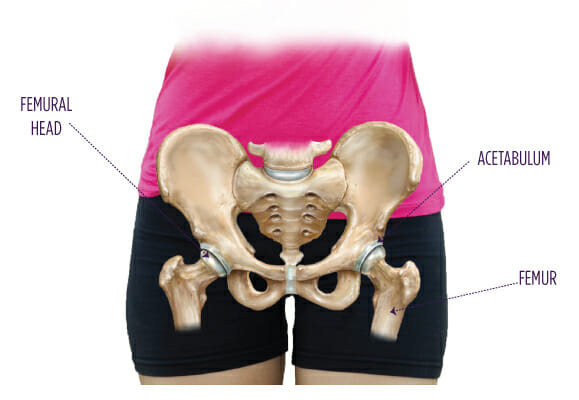The hip is a ball-and-socket joint.
- The ball portion is the rounded head of the femur (thighbone).
- The socket is the shallow cup called the acetabulum.
- These surfaces are coated in articular cartilage, which is a smooth, gliding surface.
- The outer portion of the socket is lined with a ring of cartilage called the labrum, which acts as a bumper to give the hip joint stability.
Learn more about hip anatomy

What is femoroacetabular impingement (FAI)?
Femoroacetabular impingement (FAI) happens when the ball and socket rub together abnormally, causing damage to the hip joint over time.
There are two broad types of FAI:
- Cam impingement means that the ball is out-of-round with too much bone. It is more common in men.
- Pincer impingement means that the socket is too deep and hangs over the ball. It is more common in women.
Most hips with FAI have elements of both cam and pincer impingement. Over time, FAI can cause the labrum to fray or tear.
Why does the hip labrum tear?
FAI can cause the labrum around the hip joint to get pinched. Activities such as running, playing basketball, skiing, yoga, or dancing can cause repetitive trauma to the labrum between the cam or pincer lesions. This damage may cause a tear to develop.
Once the labrum tears, it does not function as well as it should. Labral tears can cause pain that is often felt in the groin or at the top of the hip.
What are the symptoms of FAI and labral tears?
Symptoms of FAI and labral tears include:
- Groin pain
- Difficulty putting on socks and shoes
- Difficulty getting in and out of a car
- Locking, catching, or clicking in the hip
How are FAI and labral tears diagnosed?
The diagnostic process starts by talking with you about your symptoms and conducting a detailed physical examination. Diagnostic imaging, including X-rays and MRI scans, can be useful for a diagnosis as well.
How are FAI and labral tears treated?
Most people experience relief from FAI and labral tears with conservative, nonsurgical treatment. Based on the severity of symptoms, treatment options may include:
- Anti-inflammatory medication
- Cortisone injections
- Orthotics
- Physical therapy
If nonsurgical treatment is not effective, surgery may be appropriate. Your surgeon will discuss whether hip arthroscopy is right for you.
What can I do at home to treat FAI and labral tears?
Home treatment for FAI and labral tears includes:
- Rest
- Ice packs to the affected area
- Anti-inflammatory medications to relieve pain and swelling
- Weight loss, to reduce pressure on the hip
- Exercises for the hip
- Avoiding activities that cause pain
More resources for you
- Read about the causes of knee and hip joint pain
